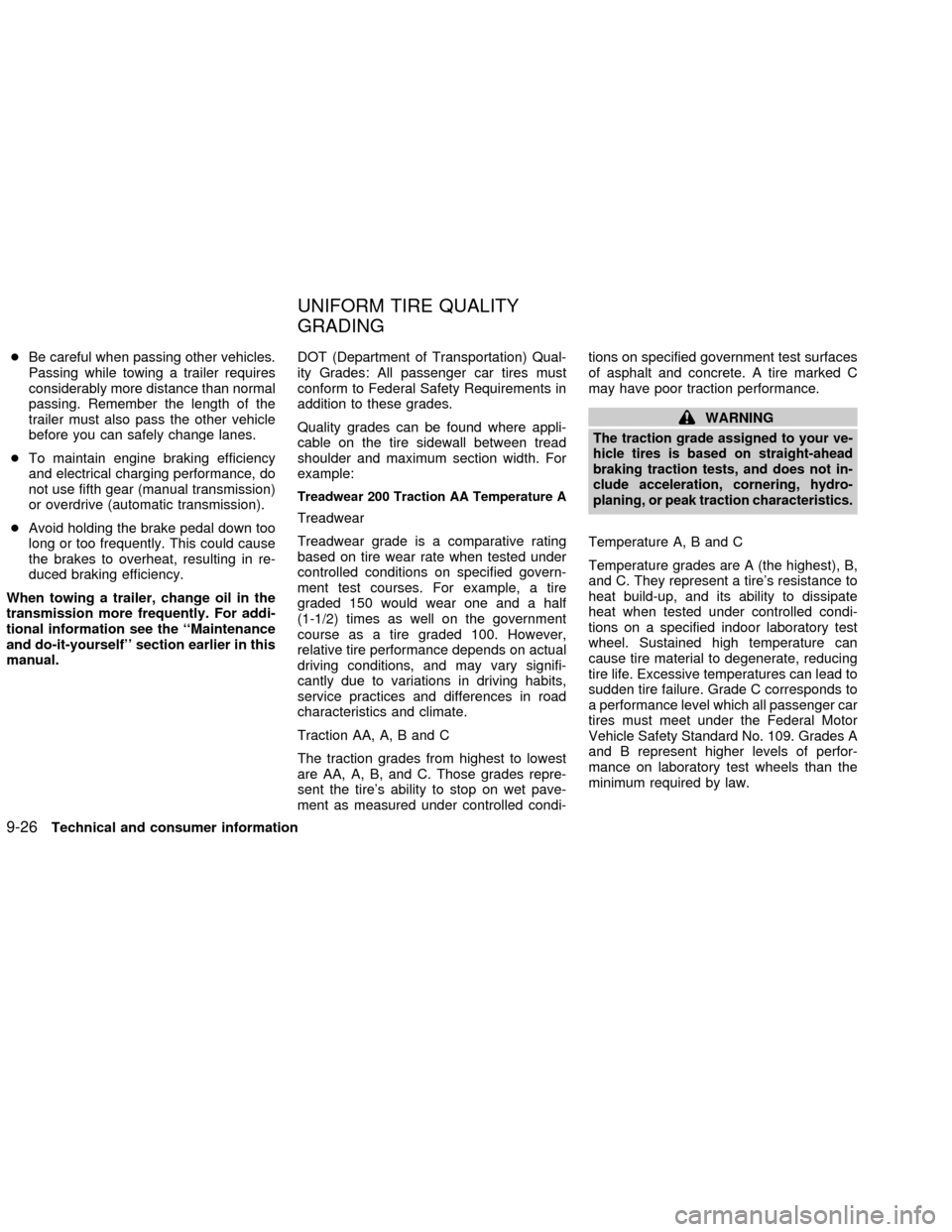2002 NISSAN FRONTIER engine overheat
[x] Cancel search: engine overheatPage 258 of 273

trailer is hitched. Do not drive the vehicle
if it has an abnormal nose-up or nose-
down condition; check for improper
tongue load, overload, worn suspension
or other possible causes of either con-
dition.
cAlways secure items in the trailer to
prevent load shift while driving.
cBe certain your outside mirrors conform
to all federal, state or local regulations. If
not, install any mirrors required for tow-
ing before driving the vehicle.
Trailer towing tips
In order to gain skill and an understanding
of the vehicle's behavior, you should prac-
tice turning, stopping and backing up in an
area which is free from traffic. Steering,
stability and braking performance will be
somewhat different than under normal driv-
ing conditions.
cAlways secure items in the trailer to
prevent load shift while driving.
c
Avoid abrupt starts, acceleration or
stops.
cAvoid sharp turns or lane changes.cAlways drive your vehicle at a moderate
speed.
cAlways block the wheels on both vehicle
and trailer when parking. Parking on a
slope is not recommended; however, if
you must do so, and if your vehicle is
equipped with automatic transmission,
first block the wheels and apply the
parking brake, and then move the trans-
mission shift selector lever into the P
(Park) position. If you move the shift
lever to the P (Park) position before
blocking the wheels and applying the
parking brake, transmission damage
could occur.
cWhen going down a hill, shift into a lower
gear and use the engine braking effect.
When ascending a long grade, down-
shift the transmission to a lower gear
and reduce speed to reduce chances of
engine overloading and/or overheating.
However, for long steep grades, do not
stay in 1st or 2nd gear when driving
above 35 MPH (56 km/h).
cIf the engine coolant rises to an ex-
tremely high temperature when the air
conditioning system is on, turn off the air
conditioner. Coolant heat can be addi-tionally vented by opening the windows,
switching the fan control to high and
setting the temperature control to the
HOT position.
cTrailer towing requires more fuel than
normal circumstances.
cAvoid towing a trailer for your vehicle's
first 500 miles (805 km).
cHave your vehicle serviced more often
than at intervals specified in the recom-
mended Maintenance Schedule.
cWhen making a turn, your trailer wheels
will be closer to the inside of the turn
than your vehicle wheels. To compen-
sate for this, make a larger than normal
turning radius during the turn.
cCrosswinds and rough roads adversely
affect vehicle/trailer handling, possibly
causing vehicle sway. When being
passed by larger vehicles, be prepared
for possible changes in crosswinds that
could affect vehicle handling. If swaying
does occur, firmly grip the steering
wheel, steer straight ahead, and imme-
diately (but gradually) reduce vehicle
speed. This combination helps to stabi-
lize the vehicle. Never increase speed.
Technical and consumer information
9-25
ZX
Page 259 of 273

cBe careful when passing other vehicles.
Passing while towing a trailer requires
considerably more distance than normal
passing. Remember the length of the
trailer must also pass the other vehicle
before you can safely change lanes.
cTo maintain engine braking efficiency
and electrical charging performance, do
not use fifth gear (manual transmission)
or overdrive (automatic transmission).
cAvoid holding the brake pedal down too
long or too frequently. This could cause
the brakes to overheat, resulting in re-
duced braking efficiency.
When towing a trailer, change oil in the
transmission more frequently. For addi-
tional information see the ``Maintenance
and do-it-yourself'' section earlier in this
manual.DOT (Department of Transportation) Qual-
ity Grades: All passenger car tires must
conform to Federal Safety Requirements in
addition to these grades.
Quality grades can be found where appli-
cable on the tire sidewall between tread
shoulder and maximum section width. For
example:
Treadwear 200 Traction AA Temperature A
Treadwear
Treadwear grade is a comparative rating
based on tire wear rate when tested under
controlled conditions on specified govern-
ment test courses. For example, a tire
graded 150 would wear one and a half
(1-1/2) times as well on the government
course as a tire graded 100. However,
relative tire performance depends on actual
driving conditions, and may vary signifi-
cantly due to variations in driving habits,
service practices and differences in road
characteristics and climate.
Traction AA, A, B and C
The traction grades from highest to lowest
are AA, A, B, and C. Those grades repre-
sent the tire's ability to stop on wet pave-
ment as measured under controlled condi-tions on specified government test surfaces
of asphalt and concrete. A tire marked C
may have poor traction performance.
WARNING
The traction grade assigned to your ve-
hicle tires is based on straight-ahead
braking traction tests, and does not in-
clude acceleration, cornering, hydro-
planing, or peak traction characteristics.
Temperature A, B and C
Temperature grades are A (the highest), B,
and C. They represent a tire's resistance to
heat build-up, and its ability to dissipate
heat when tested under controlled condi-
tions on a specified indoor laboratory test
wheel. Sustained high temperature can
cause tire material to degenerate, reducing
tire life. Excessive temperatures can lead to
sudden tire failure. Grade C corresponds to
a performance level which all passenger car
tires must meet under the Federal Motor
Vehicle Safety Standard No. 109. Grades A
and B represent higher levels of perfor-
mance on laboratory test wheels than the
minimum required by law.
UNIFORM TIRE QUALITY
GRADING
9-26Technical and consumer information
ZX
Page 269 of 273

Overheat
If your vehicle overheats ...................... 6-10
Owner's manual order form ....................... 9-30
P
Parking
Parking brake check ............................. 8-26
Parking brake operation ....................... 5-16
Parking/parking on hills ........................ 5-24
Passenger supplemental air bag ON/OFF
switch and light
Passenger supplemental air bag
ON/OFF switch and light ...................... 1-13
Power
Power door locks .................................... 3-3
Power steering fluid .............................. 8-17
Power steering system ......................... 5-25
Power windows..................................... 2-27
Precautions
Maintenance precautions ....................... 8-5
On-pavement and off-road driving
precautions ............................................. 5-3
Precautions on seat belt usage............ 1-18
Precautions when starting and driving ... 5-2
Push starting ................................................ 6-9
R
Radio
Car phone or CB radio ......................... 4-32FM-AM radio with cassette player and
compact disc (CD) player ..................... 4-13
FM-AM radio with compact disc (CD)
changer ................................................. 4-18
Steering wheel audio control switch ..... 4-31
Readiness for inspection maintenance
(I/M) test..................................................... 9-28
Rear sliding window................................... 2-29
Rear window defogger switch ................... 2-19
Registering your vehicle in another
country ....................................................... 9-12
Remote keyless entry system .................... 3-4
Reporting safety defects (USA) ................. 9-28
Roof rack (see luggage rack) ...................... 3-9
S
Safety
Reporting safety defects (USA) ............ 9-28
Seat
Jump seat ............................................... 1-5
Seat belt
Precautions on seat belt usage............ 1-18
Seat belt extenders .............................. 1-26
Seat belt maintenance.......................... 1-26
Seat belts.............................................. 1-18
Three-point type with retractor ............. 1-21
Two-point type without retractor ........... 1-24
Seat belt warning light ............................... 2-13
Seats
Adjustment .............................................. 1-2
Separate seats ....................................... 1-2Service manual order form ........................ 9-30
Shifting
Automatic transmission ........................ 5-10
Manual transmission............................. 5-15
Spark plug replacement............................. 8-21
Speedometer ............................................... 2-3
Spotlights (See map light) ......................... 2-33
SRS warning label ..................................... 1-16
Starting
Before starting the engine ...................... 5-8
Jump starting .......................................... 6-8
Precautions when starting and driving ... 5-2
Push starting........................................... 6-9
Starting the engine ................................. 5-8
Steering
Power steering fluid .............................. 8-17
Power steering system ......................... 5-25
Tilting steering wheel............................ 3-12
Steering wheel audio control switch .......... 4-31
Step rail...................................................... 3-11
Stop light .................................................... 8-35
Sun shade.................................................. 2-31
Sunroof ...................................................... 2-30
Supplemental restraint system
(Supplemental air bag system).................... 1-6
Switch
Automatic power window switch .......... 2-29
Hazard warning flasher switch ............. 2-22
Headlight and turn signal switch .......... 2-20
Overdrive switch.......................... 5-13, 5-14
Passenger supplemental air bag
ON/OFF switch and light ...................... 1-13
10-4
ZX